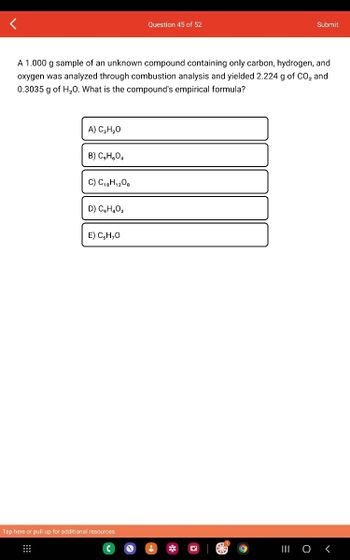
Chemistry
10th Edition
ISBN: 9781305957404
Author: Steven S. Zumdahl, Susan A. Zumdahl, Donald J. DeCoste
Publisher: Cengage Learning
expand_more
expand_more
format_list_bulleted
Concept explainers
Question
A 1.000 g sample of an unknown compound containing only carbon, hydrogen, and oxygen was analyzed through combustion analysis and yielded 2.224 g of CO2 and 0.3035 g of H20. What is the compound's empirical formula?

Transcribed Image Text:A) C₂H₂O
A 1.000 g sample of an unknown compound containing only carbon, hydrogen, and
oxygen was analyzed through combustion analysis and yielded 2.224 g of CO₂ and
0.3035 g of H₂O. What is the compound's empirical formula?
B) C₂H₂O4
C) C₁8H₁208
D) C₂H4O₂
E) C,H,O
Question 45 of 52
Tap here or pull up for additional resources
Submit
||| 0 <
Expert Solution
This question has been solved!
Explore an expertly crafted, step-by-step solution for a thorough understanding of key concepts.
This is a popular solution
Trending nowThis is a popular solution!
Step by stepSolved in 3 steps with 3 images

Knowledge Booster
Learn more about
Need a deep-dive on the concept behind this application? Look no further. Learn more about this topic, chemistry and related others by exploring similar questions and additional content below.Similar questions
- A 3.06 mg sample of a compound containing carbon, hydrogen, and oxygen underwent combustion producing 6.95 mg of CO2 and 2.84 mg of H2O. What is the empirical formula of the compound? If the compound has a molar mass of 160 ± 5 g/mol, what is its molecular formula?arrow_forwardIf you have 1 mol Xe and 1 mol F₂, how many moles of XeF₄ can you create in the following chemical reaction? Xe (g) + 2 F₂ (g) → XeF₄ (g)arrow_forwardThe reaction 2 Sb + 3 Cl2 → 2 SbCl3 has an 88.3% yield. If 4.93 g of SbCl3 is desired, what mass of chlorine should be used?arrow_forward
- A given compound is analyzed and found to contain only C, H and O. When a 35.79 g sample of this compound is completely combusted in the presence of excess oxygen, the reaction yields 49.19 g of carbon dioxide and 13.43 g of water. What is the empirical formula of this compound?arrow_forwardSmall quantities of oxygen can be prepared in the laboratory by heating potassium chlorate, KClO3(s). The equation for the reaction is 2KClO3⟶2KCl+3O2 Calculate how many grams of O2(g) can be produced from heating 12.2 g KClO3(s).arrow_forwardWhen 5.974 grams of a hydrocarbon, CxHy, were burned in a combustion analysis apparatus, 18.74 grams of CO2 and 7.675 grams of H2O were produced.In a separate experiment, the molar mass of the compound was found to be 56.11 g/mol. Determine the empirical formula and the molecular formula of the hydrocarbon.arrow_forward
- A 37.169 mg sample of a chemical known to contain only carbon, hydrogen, sulfur, and oxygen is put into a combustion analysis apparatus, yielding 66.214 mg of carbon dioxide and 27.105 mg of water. In another experiment, 25.711 mg of the compound is reacted with excess oxygen to produce 11.11 mg of sulfur dioxide. Identify the empirical formula of the compound.arrow_forwardWhen 5.762 g of a compound composed of only carbon, hydrogen, and oxygen was submitted to combustion analysis, it produced 10.557 g CO₂ and 2.882 g H₂O. What is its empirical formula?arrow_forwardWhen a 10.0 g sample of an unknown organic acid is subjected to combustion analysis 21.2 grams of CO2 and 3.25 g of H2O are produced. The molar mass of the acid is 165. What are the empirical formula and the molecular formula of the acid?arrow_forward
- An unknown compound that is composed of C, H and O atoms was submitted to a lab for determination of formula. Combustion in air of 1.230 g of the unknown compound yields 2.162 g CO2 and 1.033 g H2O. What is the empirical formula of the unknown compound?arrow_forwardCombustion analysis of 2.796 g of an unknown compound containing carbon, hydrogen, and oxygen produced 5.597 g of CO2 and 2.268 g of H2O. What is the empirical formula of the compound?arrow_forwardUpon combustion, a 0.8009 gg sample of a compound containing only carbon, hydrogen, and oxygen produces 1.6004 gg CO2CO2 and 0.6551 gg H2OH2O. Find the empirical formula of the compound.arrow_forward
arrow_back_ios
SEE MORE QUESTIONS
arrow_forward_ios
Recommended textbooks for you
 ChemistryChemistryISBN:9781305957404Author:Steven S. Zumdahl, Susan A. Zumdahl, Donald J. DeCostePublisher:Cengage Learning
ChemistryChemistryISBN:9781305957404Author:Steven S. Zumdahl, Susan A. Zumdahl, Donald J. DeCostePublisher:Cengage Learning ChemistryChemistryISBN:9781259911156Author:Raymond Chang Dr., Jason Overby ProfessorPublisher:McGraw-Hill Education
ChemistryChemistryISBN:9781259911156Author:Raymond Chang Dr., Jason Overby ProfessorPublisher:McGraw-Hill Education Principles of Instrumental AnalysisChemistryISBN:9781305577213Author:Douglas A. Skoog, F. James Holler, Stanley R. CrouchPublisher:Cengage Learning
Principles of Instrumental AnalysisChemistryISBN:9781305577213Author:Douglas A. Skoog, F. James Holler, Stanley R. CrouchPublisher:Cengage Learning Organic ChemistryChemistryISBN:9780078021558Author:Janice Gorzynski Smith Dr.Publisher:McGraw-Hill Education
Organic ChemistryChemistryISBN:9780078021558Author:Janice Gorzynski Smith Dr.Publisher:McGraw-Hill Education Chemistry: Principles and ReactionsChemistryISBN:9781305079373Author:William L. Masterton, Cecile N. HurleyPublisher:Cengage Learning
Chemistry: Principles and ReactionsChemistryISBN:9781305079373Author:William L. Masterton, Cecile N. HurleyPublisher:Cengage Learning Elementary Principles of Chemical Processes, Bind...ChemistryISBN:9781118431221Author:Richard M. Felder, Ronald W. Rousseau, Lisa G. BullardPublisher:WILEY
Elementary Principles of Chemical Processes, Bind...ChemistryISBN:9781118431221Author:Richard M. Felder, Ronald W. Rousseau, Lisa G. BullardPublisher:WILEY

Chemistry
Chemistry
ISBN:9781305957404
Author:Steven S. Zumdahl, Susan A. Zumdahl, Donald J. DeCoste
Publisher:Cengage Learning

Chemistry
Chemistry
ISBN:9781259911156
Author:Raymond Chang Dr., Jason Overby Professor
Publisher:McGraw-Hill Education

Principles of Instrumental Analysis
Chemistry
ISBN:9781305577213
Author:Douglas A. Skoog, F. James Holler, Stanley R. Crouch
Publisher:Cengage Learning

Organic Chemistry
Chemistry
ISBN:9780078021558
Author:Janice Gorzynski Smith Dr.
Publisher:McGraw-Hill Education

Chemistry: Principles and Reactions
Chemistry
ISBN:9781305079373
Author:William L. Masterton, Cecile N. Hurley
Publisher:Cengage Learning

Elementary Principles of Chemical Processes, Bind...
Chemistry
ISBN:9781118431221
Author:Richard M. Felder, Ronald W. Rousseau, Lisa G. Bullard
Publisher:WILEY